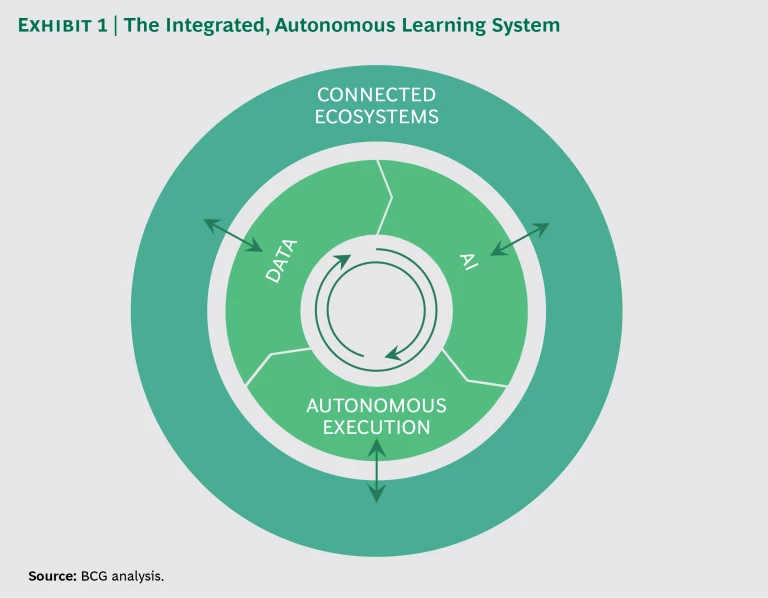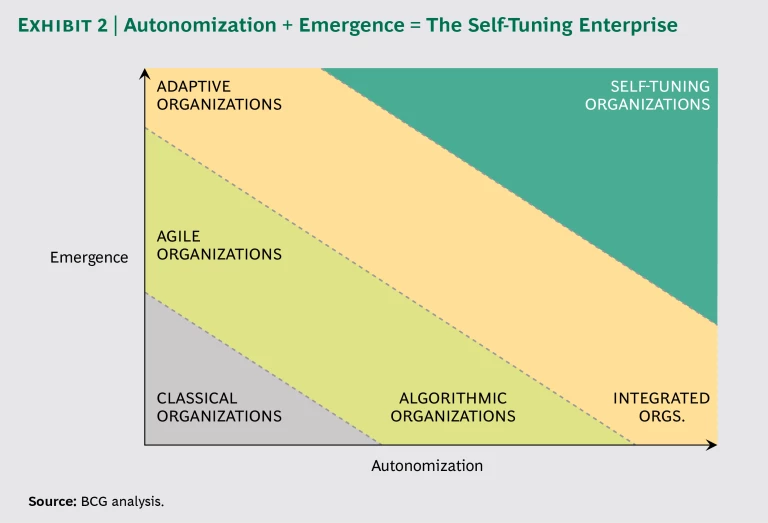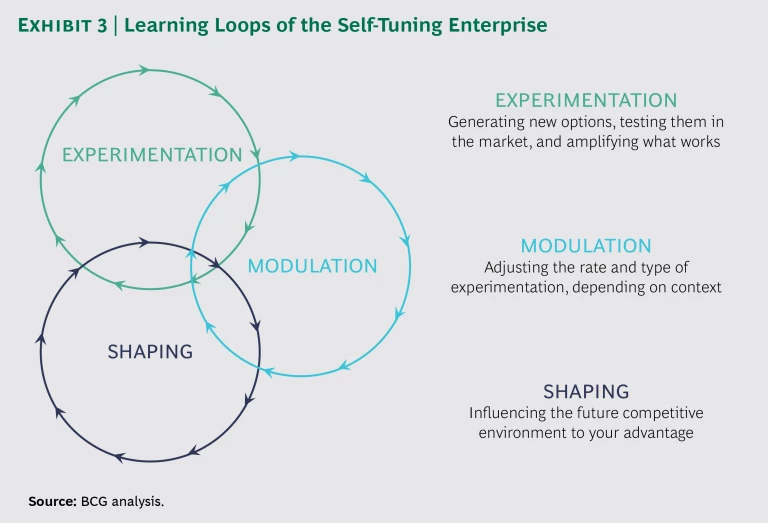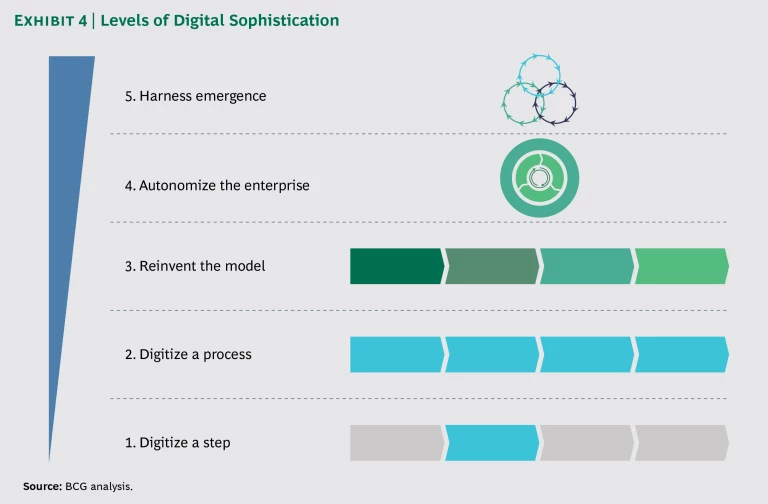I
n today’s economy, digital capability is critical for growth and competitiveness. A decade ago, only one tech company was among the top ten global firms by market capitalization. Today, seven are on that list. The tech sector is even more dominant in forward-looking metrics: it accounts for only 15% of the top US firms but 24% of the fastest-growing
Furthermore, digital players are tapping into the profit pools of other industries—consider the efforts of Uber and Google to disrupt the car industry or the impact of Netflix on film producers. Virtually every business is now a technology business and an information business, and is potentially vulnerable to disruption by digital challengers.
Well aware of those risks, many of today’s incumbents have pursued “digital transformations” in an attempt to defend against threats and seize new opportunities. Such programs generally have two aims: to automate supply chains and internal processes and to innovate by creating digital product and service offerings, as well as new business models to deliver these.
Such efforts can unlock enormous value. But they ignore two higher-level strategic impacts that digital evolution enables: autonomization and emergence. Some digital leaders are already leveraging these advantages to great effect, reinventing the enterprise model in the process. For incumbents that need to compete directly with those pioneers, or wish to anticipate where the digital game is heading, it is important to understand how these advantages work and how to realize them.
Most digital transformations ignore two higher-level strategic impacts: autonomization and emergence.
Creating Massive Learning Advantage with Autonomous Systems
Leading digital players are not merely automating traditional business processes or inventing new offerings, important though these moves may be. They are also fundamentally reinventing the operating system of the enterprise itself. Rather than following the classical managerial model, they are recasting the firm and its surrounding ecosystem as an integrated, autonomous learning system.
This involves not only adopting individual technological modalities (platforms, data, analytics, artificial intelligence, and so on) but also connecting them in a self-reinforcing system. (See Exhibit 1.) Digital leaders develop platforms that match suppliers and customers. By nurturing both sides of markets, companies create vast ecosystems of commercial activity that surround their platform services. These ecosystems generate enormous amounts of proprietary data, conferring an information advantage to the platform operator. Firms can then leverage AI to generate real-time insights on consumer and supplier behavior from the data. Finally, digital leaders wire these insights directly to action systems, enabling them to learn autonomously and optimize their services to changing conditions. The effects of these actions then reverberate throughout the ecosystem, generating new signals to fuel further decisions.
Such autonomous learning systems allow for a much higher level of segmentation and personalization than would be possible with a traditional managerial system, which is constrained by the bandwidth and speed limits of human cognition and hierarchical organizations. For example, the offering, pricing, and other aspects of the marketing mix can be tailored to each customer and updated continuously and automatically in response to changing conditions.
Most important, autonomous systems can easily outcompete traditional models on their rate of learning in complex, dynamic environments. The classical principles of the experience curve and time-based competition are endowed with new power through this switch from in vivo to in silico coordination and from the creation of closed learning loops.
Autonomous systems can easily outcompete traditional models on their rate of learning in complex environments.
The Power of Emergence
Autonomous learning systems can also unleash the power of emergence—the creation of a plethora of options beyond those explicitly planned or foreseen by a managerial process. In an increasingly complex and dynamic business environment, it is unrealistic to think that leaders will be able to envision or predict all relevant scenarios and the optimal responses to each. Thus, harnessing emergence becomes a strategic imperative in the fast-evolving digital age—effectively liberating the firm from the constraints of classical planning and unlocking the creative potential of an evolutionary process.
When the effects of autonomization and emergence are combined, they reinvent the operating model of the firm to create a self-tuning enterprise —one that learns and innovates at the “speed of data” to pull ahead of competitors. (See Exhibit 2.)
Triple-Loop Learning in the Self-Tuning Enterprise
Self-tuning firms effectively harness three learning loops. (See Exhibit 3.) They systematically experiment to learn more about customer needs (for example, by A/B testing different offerings). They modulate the rate of experimentation to optimize the long-run payoff (for example, by experimenting more for new customers). Finally, they shape the environment to their advantage (for example, by developing new product categories to shape and attract new demand).
Through autonomization and emergence, self-tuning firms create significant advantages. They can better understand customers by leveraging data from their own ecosystems and platforms to develop granular insights and automatically customize their offerings. They can develop more new, marketable products by experimenting with offerings and leveraging proprietary data. And they can implement change more quickly and at lower cost by acting autonomously.
The benefits of autonomization and emergence well exceed those that can be realized from digitization programs aiming to increase efficiency or product innovation alone. (See Exhibit 4.) They are compounded by self-reinforcing network and experience effects: better offerings attract more customers and more data; experimentation brings knowledge that increases the value of future experimentation.
One example of a self-tuning organization is Alibaba. Not only does its e-commerce platform provide a sea of user data, but the company uses it to generate real-time insights in a granular manner. It tunes the offering on the basis of these insights in a real-time and highly segmented manner. And it continuously reshapes the enterprise to enable it to do these things more effectively, aspiring to “submit all aspects of the company to market discipline.”
Reinventing the Management Model and Mindset of Incumbents
Achieving these goals requires a different way of thinking about managing an enterprise. Instead of the traditional, mechanical mindset—in which circumstances and outcomes are seen as being largely predictable and controllable—leaders must learn to think biologically and embrace the uncertainty and complexity of business.
Biological thinking recognizes that businesses are embedded in nested complex adaptive systems : individual employees are part of firms, which in turn are part of larger markets and industries, which are embedded in local and national economies and societies. Crucially, changes made at any level may reverberate through the entire system, with nonlinear and unpredictable effects.
As a result, deliberate actions may not have the expected outcomes. Instead, companies must make indirect interventions, finding leverage points that are observed to have a positive impact on the broader system. They must make their enterprises resilient, ensuring that unforeseeable shocks will not have catastrophic effects. And they must experiment frequently, recognizing that there is often no way to predict what patterns will emerge.
A Leadership Agenda for Harnessing Autonomization and Emergence
In order to access the advantages of autonomization and emergence, incumbents need to reframe and expand the concept of “digital transformation” to go beyond new efficiencies and products, decided upon in a planned, managerial manner. Instead, they must pursue the following actions:
Incumbents need to reframe and expand the concept of “digital transformation” to go beyond new efficiencies and products.
- Create integrated learning systems. To compete with digital pioneers, incumbents must adopt their methods and create autonomous, integrated learning systems. This involves linking data feeds from proprietary ecosystems directly to decision engines, thus enabling autonomous action and rapid learning.
For example, Netflix engages its audience by making customized content recommendations to each user. The company reported in 2012 that three-quarters of viewings originated from such suggestions. To make personalized recommendations at such scale, the company leverages an autonomous, integrated learning system that receives feedback (in the form of user ratings or viewer behavior) and updates suggestions accordingly. And it deliberately introduces variation into its recommendations, allowing new behaviors to emerge and letting the data speak for itself.
- Shift human creativity to high-level tasks. As digital technology evolves, the comparative advantages of humans and machines are shifting. For problems that involve data acquisition, processing, and decision making, algorithms should be given autonomy, removing the bottleneck of human decision making. People should instead be focused on “meta” tasks, like building and refining the autonomous learning systems, expanding ecosystems, or originating and designing entirely new business systems. The result is an organization that appropriately leverages humans and technology in a new balance—what we call an integrated strategy machine .
For example, Amazon’s dozens of data science systems are closely integrated, which allows decision engines to react to new data immediately and consistently. A rise in the popularity of one product in the market triggers automatic changes in the supply chain system (to optimize inventory), the recommendation engine (to suggest that product more often), and the pricing system (to optimize profits). Amazon calls this approach “hands off the wheel.” Humans focus their creativity on higher-level problems, such as specifying and evolving the design of those systems to account for new strategic priorities.
- Embrace biological thinking. To achieve autonomization and emergence, companies must abandon the top-down, mechanistic mindset that characterizes the traditional management model. They must instead embrace the inherent complexity of business, recognizing that circumstances change, knowledge is always incomplete, causality is complex, and outcomes are unpredictable. Instead of relying on unchanging unitary plans, companies must create and influence collaborative ecosystems, and experiment and co-evolve to find the best path forward.
For example, the Japanese firm Recruit orchestrates ecosystems of suppliers and customers that bridge the digital and physical economies . Recognizing the transformational possibilities, Recruit builds entrepreneurial capabilities to develop new sources of growth, investing in more than a dozen ecosystems so far and soliciting thousands of employee recommendations. And rather than making unilateral interventions into ecosystems for its own short-term benefit, the firm has emphasized co-evolution with other stakeholders to shape opportunities. As a result, this incumbent company is thriving in the digital environment, achieving nearly 20% annual growth over the past five years.
Digital challengers are reshaping the global economy, leaving many incumbents at risk of disruption. Digital transformation programs aimed at increasing efficiency or innovation can have significant benefits, but they also leave much on the table. To compete with leading tech players on their rate of learning, firms must use technology to achieve autonomization and emergence, and in so doing reinvent the enterprise operating model.
The BCG Henderson Institute is Boston Consulting Group’s strategy think tank, dedicated to exploring and developing valuable new insights from business, technology, and science by embracing the powerful technology of ideas. The Institute engages leaders in provocative discussion and experimentation to expand the boundaries of business theory and practice and to translate innovative ideas from within and beyond business. For more ideas and inspiration from the Institute, please visit
Featured Insights
.













